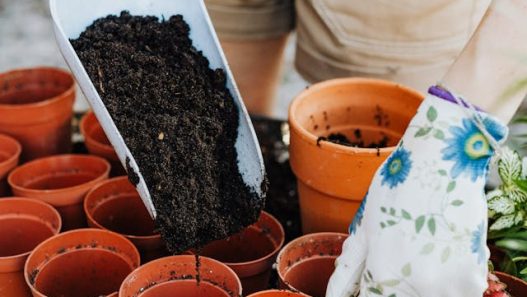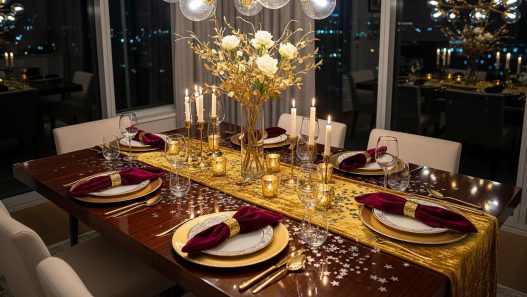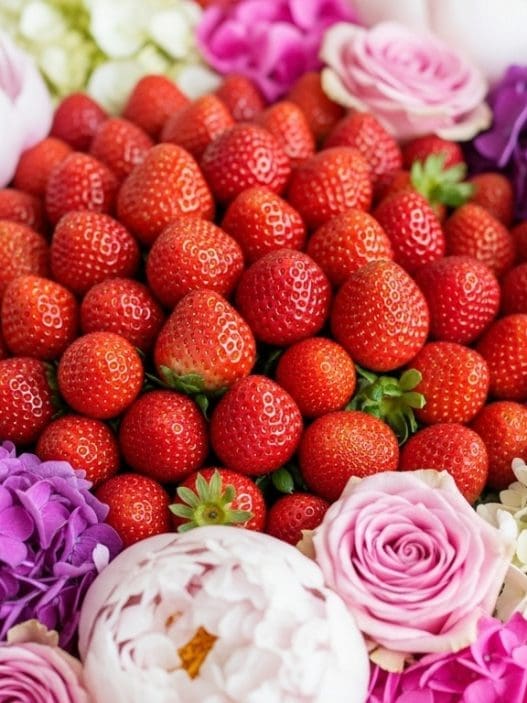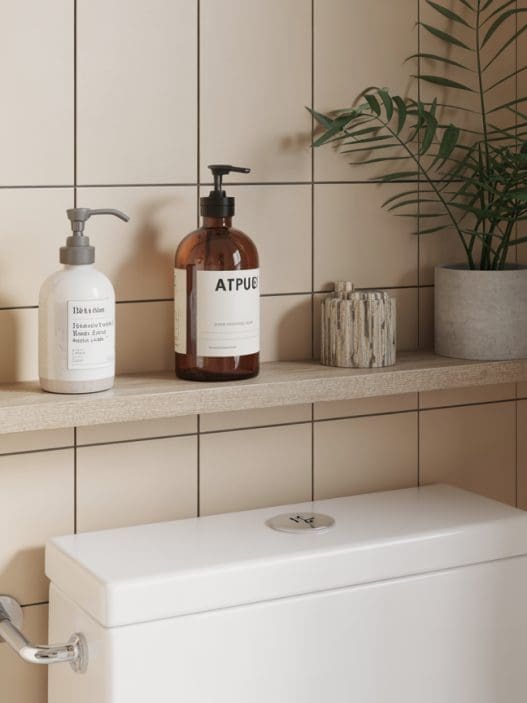Decorating with plates is one of the most timeless and budget-friendly ways to add character to your home. Whether you’re working with heirloom china, thrift store finds, or handmade ceramic pieces, hanging plates on the wall offers a creative way to showcase color, texture, and history in any room. In this guide, we explore hanging plates on the wall ideas that go beyond the traditional display, offering clever, visually balanced, and design-forward solutions that suit various interior styles.
We’ll cover 20 actionable and beginner-friendly ideas to help you use hanging plates as functional wall art. Each approach includes the reasoning behind the layout, style, and execution, so you can decorate with confidence and creativity while making the most of your plate collection.
1. Create a Symmetrical Plate Grid
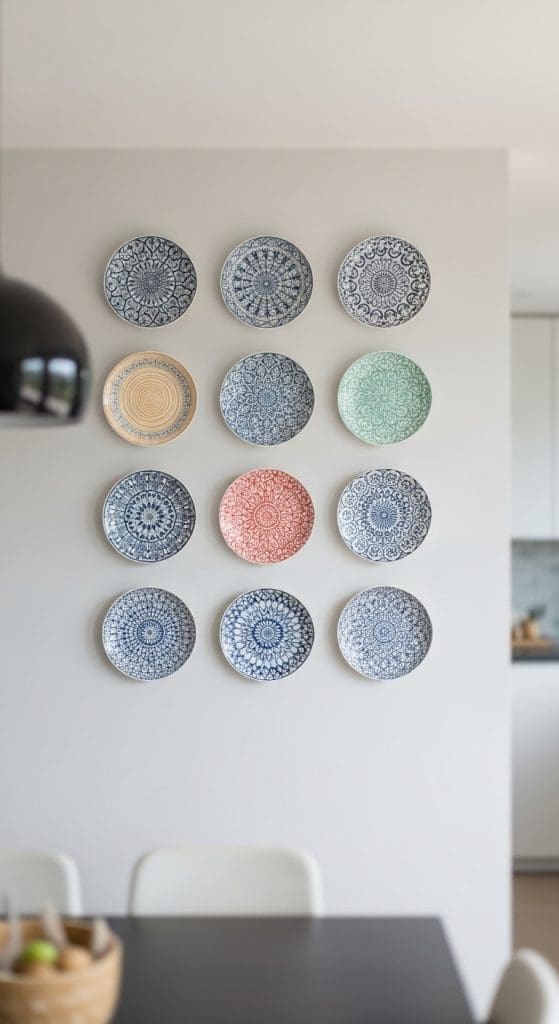
We suggest using a grid layout if you want a clean, structured design that mirrors modern gallery walls. This method works well when using plates of the same size and shape because it creates visual order and geometric balance. The logic here is rooted in visual perception: symmetry draws the eye evenly across the display, which brings a sense of calm and intention to the room. This is one of the best hanging plates on the wall ideas for formal dining rooms or minimal kitchens.
2. Try a Randomized Cluster Pattern
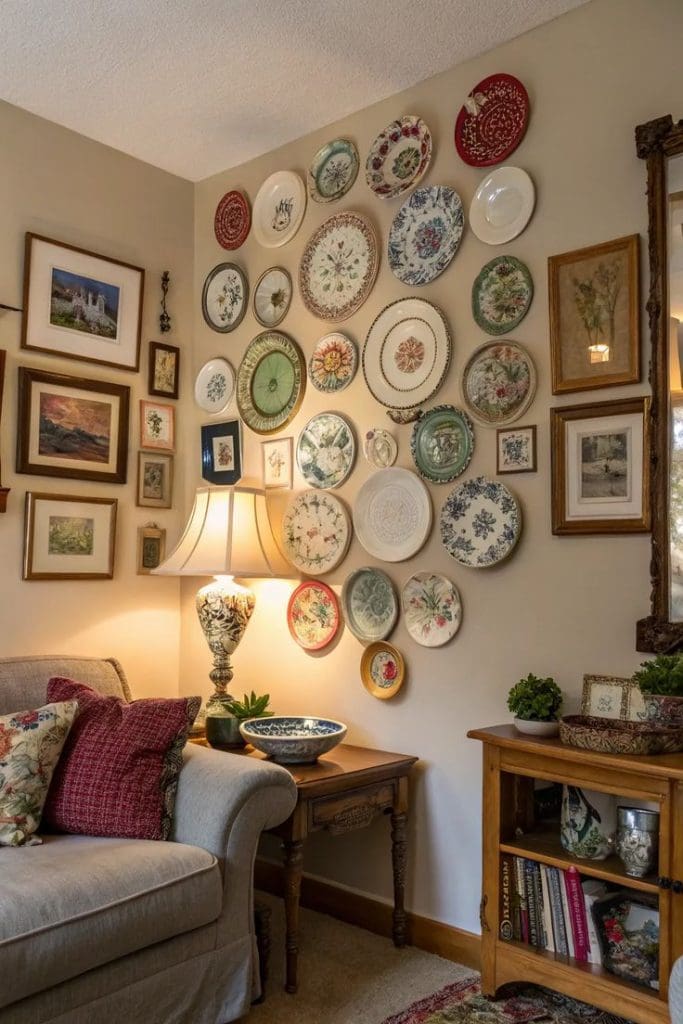
When you use various plate sizes and designs, a clustered layout feels organic and artistic. The principle at work here is asymmetrical balance, which relies on different elements being arranged in a way that still feels visually stable. We recommend placing the largest plate at the center and working outward with smaller ones, adjusting spacing as needed. This type of plate wall fits well in boho, eclectic, or farmhouse-inspired interiors.
3. Frame a Mirror or Artwork with Plates
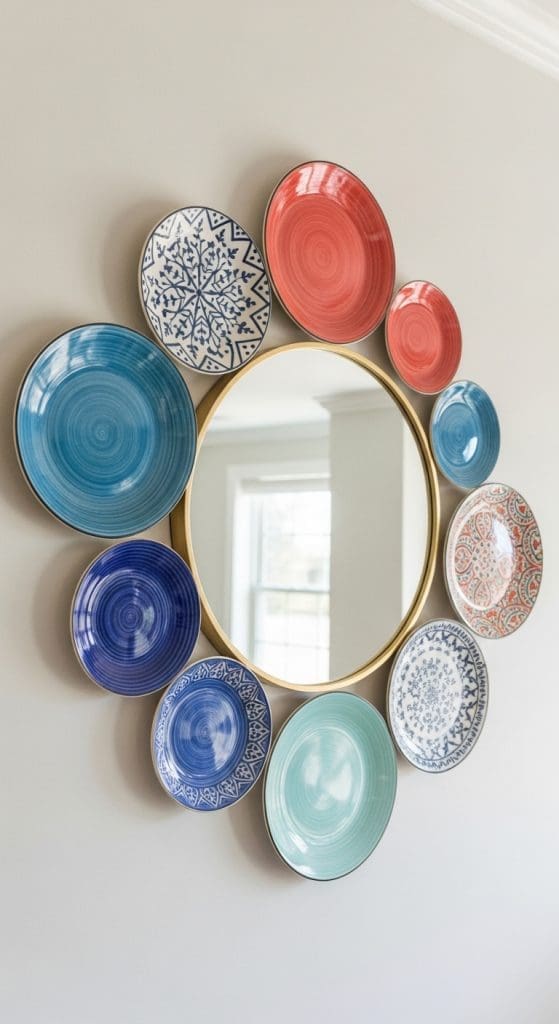
Hanging plates in a circular or rectangular formation around a mirror or central artwork adds depth and decorative layering. From a design standpoint, framing helps define focal points, and the repetition of round shapes reinforces symmetry. We suggest choosing plates that complement the color or style of the center piece to tie the arrangement together. This is a practical way to turn a small mirror into a major statement piece.
4. Use Plates to Fill Vertical Space

Tall, narrow walls often go unused because standard art doesn’t fit proportionally. Hanging plates in a vertical column is an effective solution that elongates the wall and draws the eye upward. This layout works especially well in entryways or between windows. We recommend using similar plate designs to keep the display cohesive and avoid visual clutter.
5. Hang Plates Over the Bed
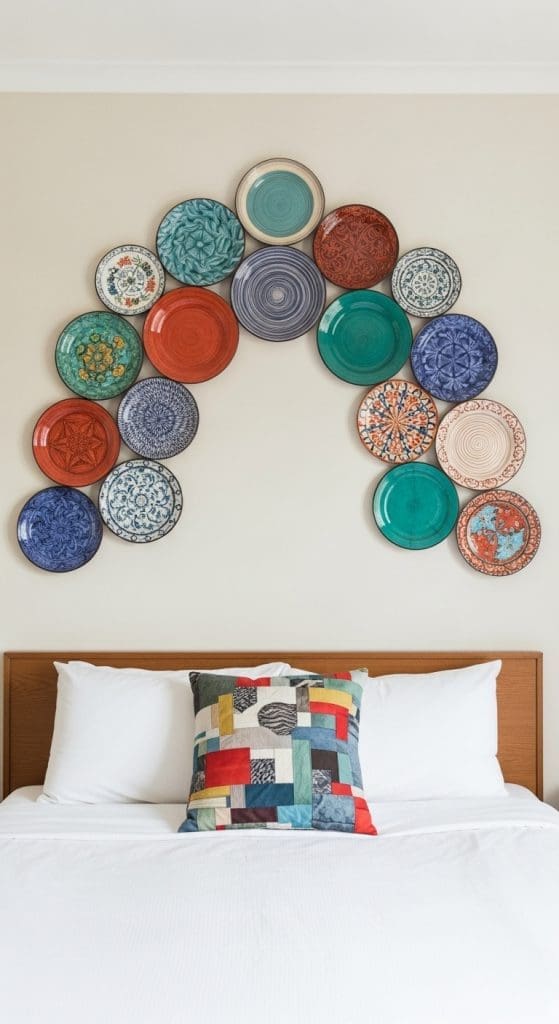
We suggest this idea as a creative alternative to framed art or headboards. Plates can be arranged in an arc or a layered pattern above the bed, softening the space and adding texture. Psychologically, curved shapes like circles tend to feel calming, making them ideal for bedrooms. Make sure to use secure wall hangers to prevent any risk of falling.
6. Display Plates Along a Staircase Wall

Staircase walls benefit from dynamic displays that follow the slope of the stairs. We recommend arranging plates diagonally, matching the incline, while mixing plate sizes to create movement. This approach uses visual flow, leading the eye naturally up or down the staircase, making it one of the most overlooked yet impactful hanging plates on the wall ideas.
7. Outline a Door or Window with Plates
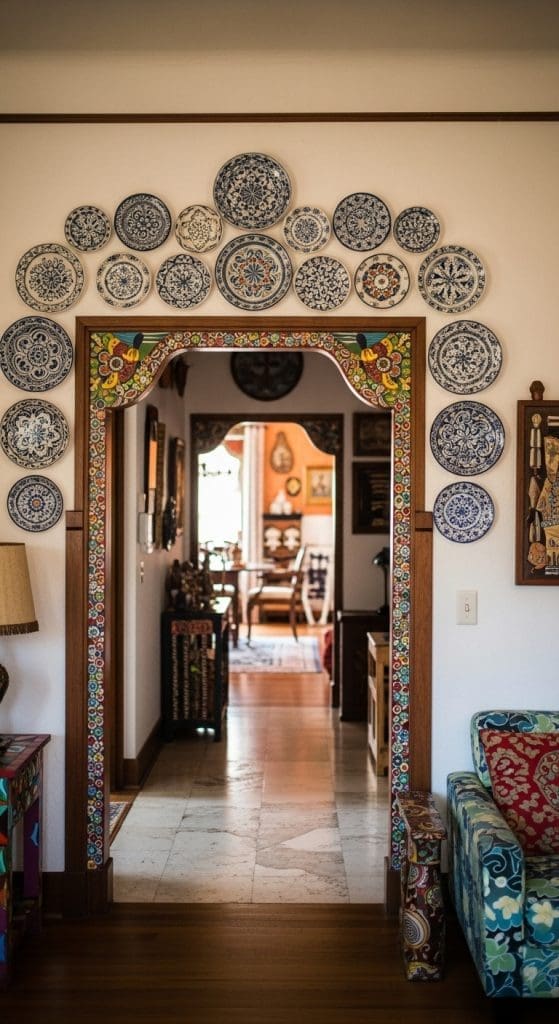
Outlining an architectural feature such as a doorframe or window using plates adds charm and makes these structures pop. The logic here is to reinforce lines that already exist in the architecture, enhancing the flow of the room. We suggest using small to medium plates and maintaining consistent spacing for the best effect.
8. Use All-White Plates for Texture

We recommend hanging all-white or neutral-toned plates to create a subtle, textural feature that adds depth without overwhelming the space. This works particularly well in Scandinavian or coastal interiors. The science behind this idea lies in light reflection: white surfaces help bounce light around the room, keeping it bright while still offering dimension.
9. Go Monochrome with a Pop of Accent Color

Using plates in various shades of one color (such as blue or green) with a single contrasting plate creates a high-impact focal point. This technique is rooted in color theory, where analogous hues provide harmony and the contrasting element introduces surprise. We suggest placing the accent plate off-center for a more modern and intentional feel.
10. Mix Vintage and Modern Plate Designs

Combining antique floral china with modern, minimalist plates creates a visually interesting contrast. This is an example of juxtaposition, a design principle where contrasting styles are placed together to enhance each other. We recommend selecting a common color palette to tie the two styles together and keep the display cohesive.
11. Hang Plates in a Clock-Like Circle
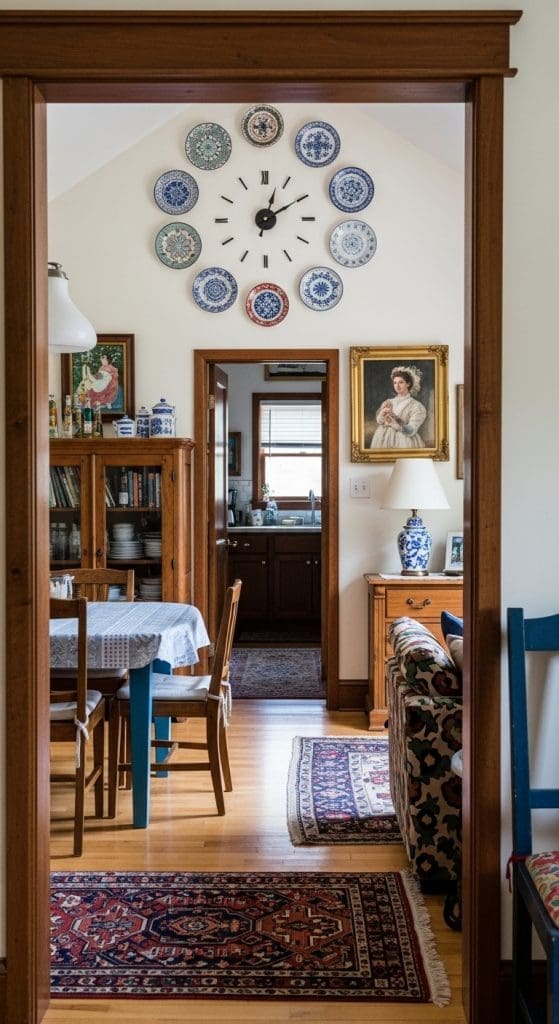
A circular arrangement mimics the face of a clock and naturally feels balanced and centered. This shape is ideal for symmetrical spaces such as over a round table or centered in a foyer. From a psychological perspective, circular patterns suggest continuity and flow, making the display feel intentional and calm.
12. Layer Plates on Top of Framed Panels
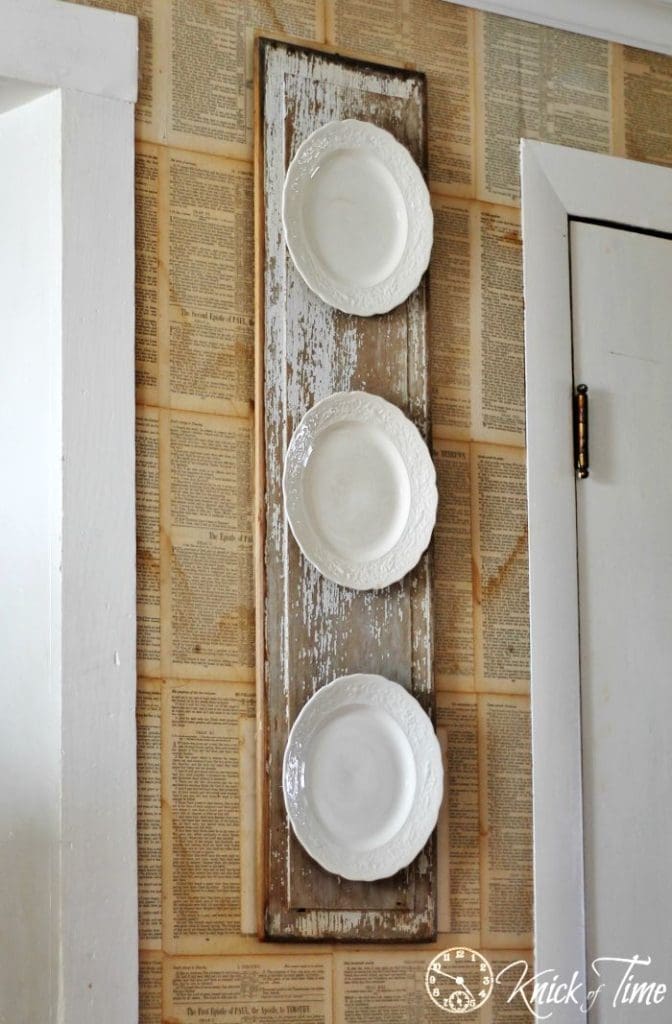
For added dimension, we recommend mounting plates onto fabric-covered or painted wood panels before hanging them. This technique adds depth and frames the plate as a piece of art. Visually, it separates the plate from the wall, giving it more presence and allowing you to match or contrast the background color with your room’s palette.
13. Use Open Shelves as a Backdrop

If you’re not ready to commit to hanging plates directly on the wall, styling them upright against the back of open shelving is a beginner-friendly alternative. The advantage here is flexibility. Shelves offer the opportunity to switch designs seasonally and layer in small objects or plants, creating a dynamic and changeable display.
14. Arrange Plates Above Kitchen Cabinets

The empty space above cabinets can be transformed into a curated gallery using plates of similar style or theme. From a visual standpoint, this draws the eye upward and makes ceilings feel higher. We recommend using plate stands or secure adhesives if traditional hangers are impractical in this location.
15. Incorporate Seasonal or Themed Collections

We recommend rotating plate displays to reflect holidays, seasons, or themes such as florals, animals, or abstract patterns. This keeps the wall display fresh and relevant. The concept of seasonal decor has psychological benefits too, helping create a sense of change and newness throughout the year.
16. Group Plates by Cultural Origin
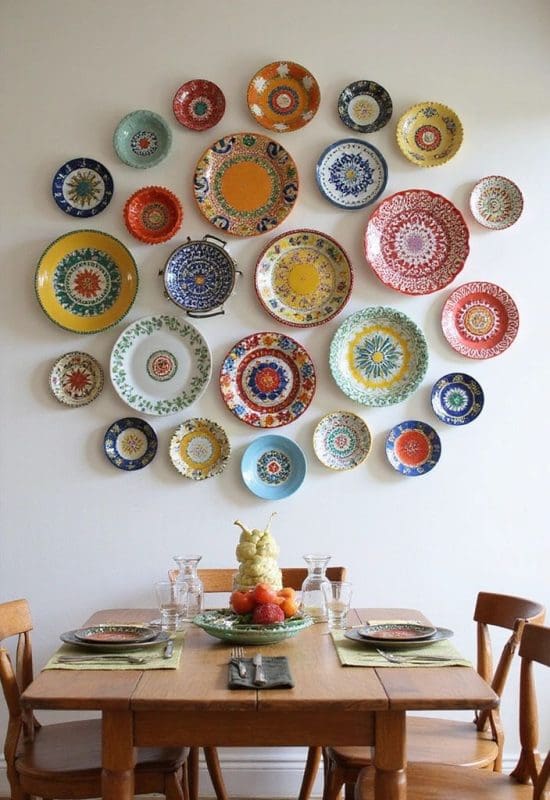
Hanging plates from specific countries or regions as a group celebrates their heritage and tells a visual story. This can be educational and decorative, highlighting craftsmanship and tradition. We suggest researching the cultural background of each piece and arranging them in a respectful and meaningful way.
17. Highlight a Color Palette Found in Your Room
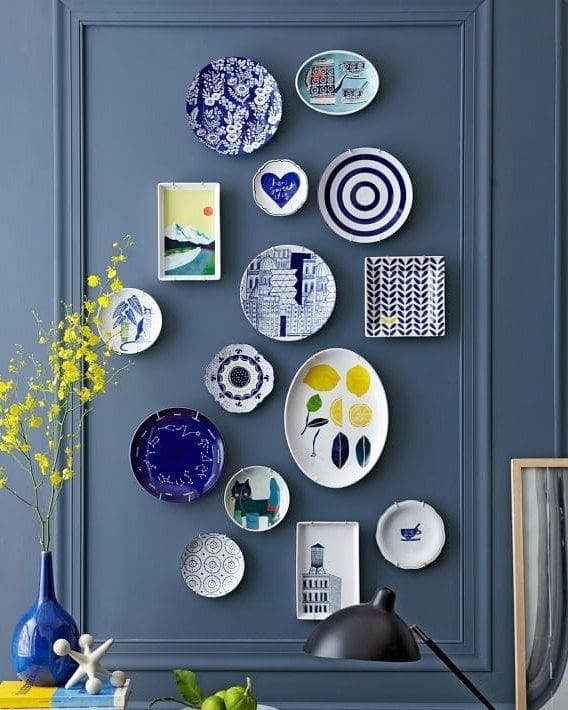
Choosing plates that reflect your existing room colors ties the display into your interior design. This approach is supported by color harmony principles, where repetition of hues across elements promotes cohesion. We recommend pulling colors from textiles, rugs, or furniture to guide your plate selection.
18. Use Plates with Text or Monograms
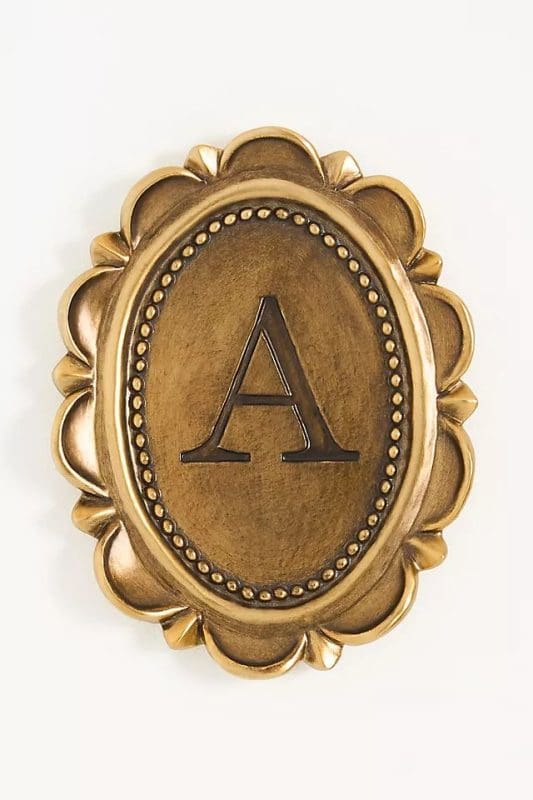
Decorative plates with inspirational quotes, family initials, or words add a personal element to your display. From a design perspective, incorporating text introduces a graphic element that contrasts nicely with more ornate plate designs. We recommend balancing text plates with plain or patterned ones to avoid visual overload.
19. Lean Plates on Picture Ledges

If you prefer flexibility and minimal wall damage, picture ledges allow you to lean plates against the wall without permanent hooks. This solution is ideal for renters or those who like to rearrange often. The logic here is adaptability: it allows you to experiment with layout and change it as your collection grows.
20. Combine Plates with Other Wall Decor

Plates don’t need to stand alone. We suggest mixing them with framed art, woven baskets, or wall sculptures for an eclectic gallery wall. This works because it introduces a variety of textures and shapes, making the wall more engaging. To avoid chaos, maintain a consistent color palette or visual rhythm across the elements.







